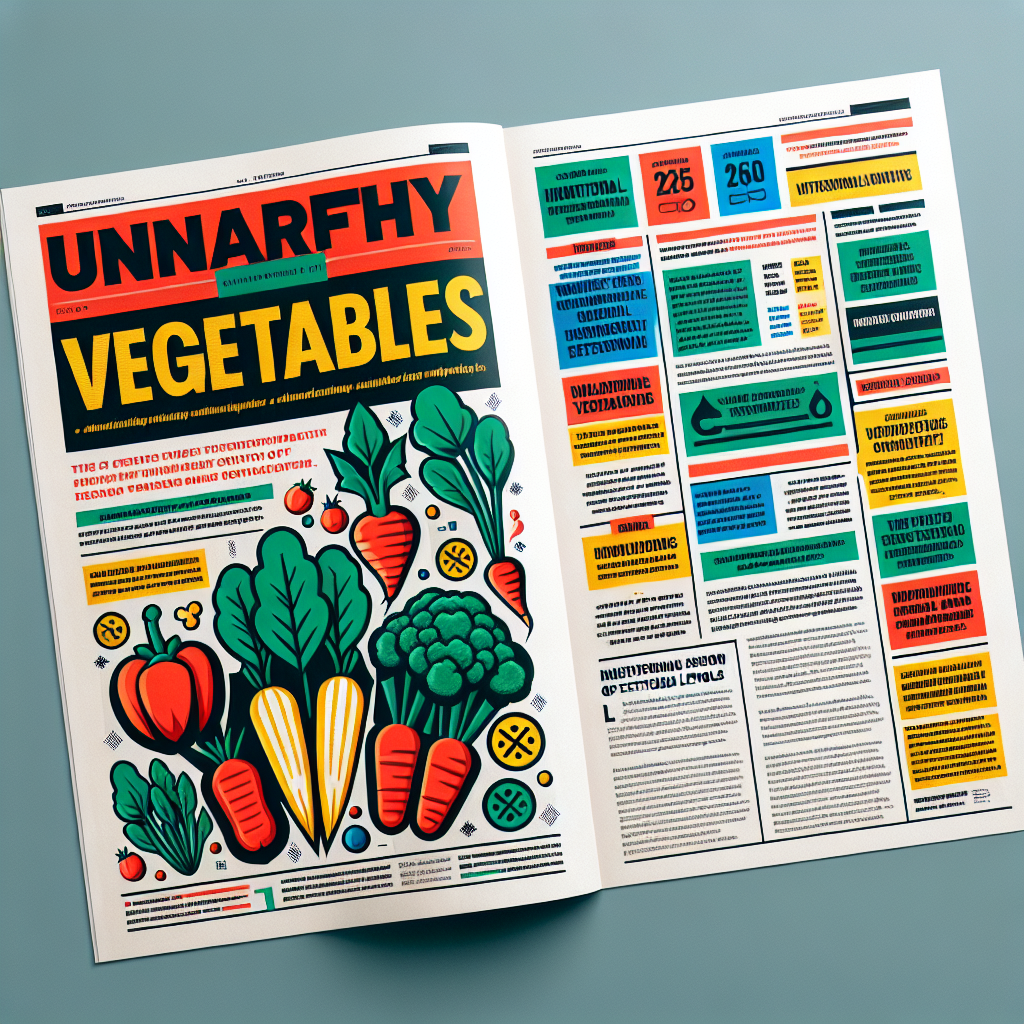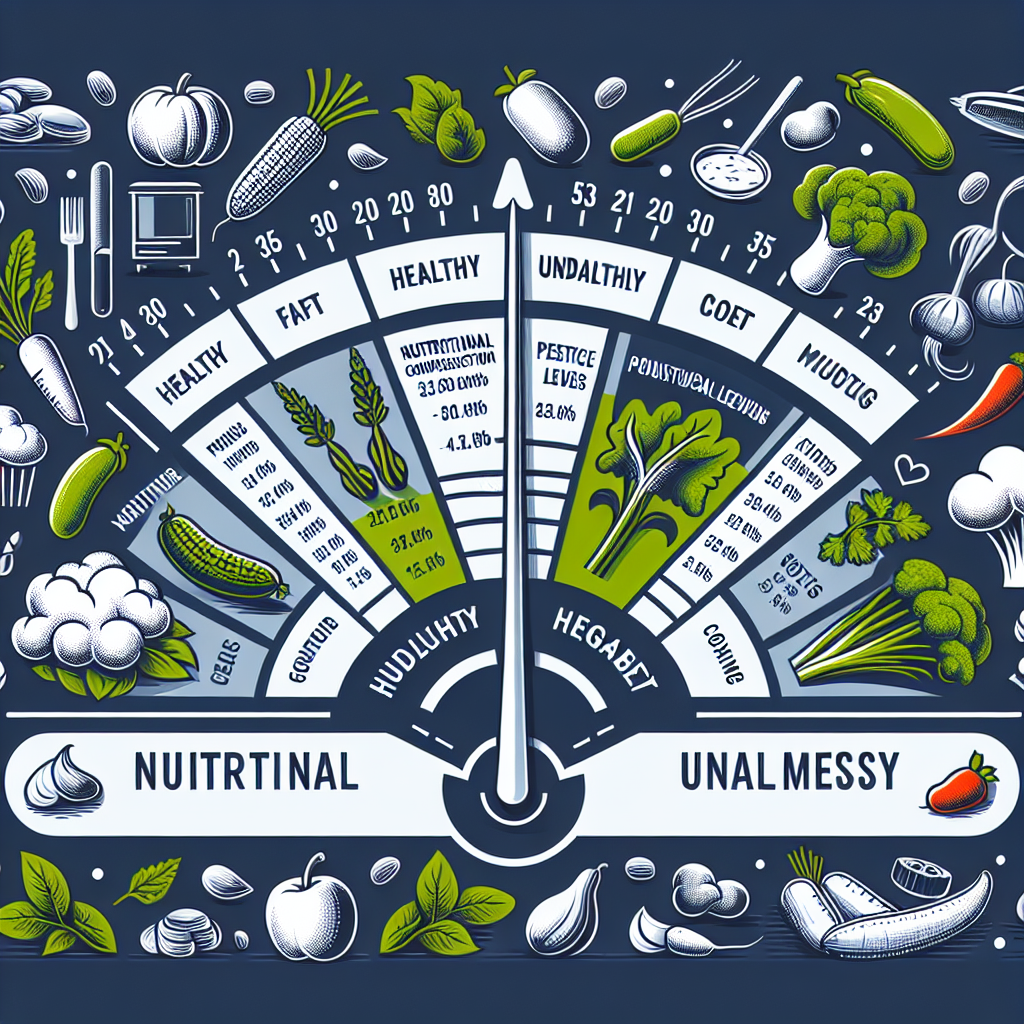Are you curious about which vegetable might not be as healthy as you thought? We all know that vegetables are an essential part of a balanced diet, but not all veggies are created equal. In this article, we will explore the question of which vegetable could potentially be considered the most unhealthy. So, grab a cup of tea, sit back, and let’s unveil the surprising truth about the healthiness of certain vegetables.

Vegetables and Health
Importance of vegetables in a healthy diet
Vegetables are an essential component of a healthy diet. They are packed with vitamins, minerals, fiber, and antioxidants that help support overall well-being. Including a variety of vegetables in your daily meals can provide numerous health benefits, such as reducing the risk of chronic diseases, improving digestion, and promoting weight management. In addition, vegetables are low in calories and high in nutrients, making them an excellent choice for maintaining a healthy weight.
Nutritional value of vegetables
Vegetables offer a wide range of nutrients that are vital for your body’s optimal functioning. They are rich in vitamins, including vitamin C, vitamin A, and vitamin K. Vitamin C helps boost your immune system and collagen production, while vitamin A is crucial for eye health and maintaining healthy skin. Vitamin K is essential for blood clotting and bone health. Vegetables are also an excellent source of minerals like potassium, magnesium, and iron. These minerals play vital roles in maintaining balanced fluid levels, supporting muscle function, and ensuring oxygen transport to your cells. Additionally, vegetables are loaded with dietary fiber, which aids in digestion, promotes satiety, and regulates blood sugar levels.
Understanding unhealthy vegetables
Although vegetables are generally considered healthy, certain factors can contribute to their unhealthiness. It is important to be aware of these factors to make informed choices and optimize the nutritional value of the vegetables you consume.
Factors Influencing Unhealthiness
Unhealthy vegetable due to pesticide residue
Pesticides are commonly used in conventional farming to protect crops from pests and diseases. However, some vegetables may retain pesticide residues, which can pose health risks when consumed in large amounts over time. It is advisable to choose organic produce or thoroughly wash and peel vegetables to minimize exposure to pesticides.
High sodium content in certain vegetables
While vegetables are generally low in sodium, some varieties have a higher sodium content. Excessive sodium intake can increase the risk of high blood pressure and other cardiovascular issues. It is important to monitor your sodium intake and limit the consumption of vegetables that are naturally high in sodium, such as canned vegetables or pickled vegetables.
Potential harm from raw consumption
While raw vegetables are often praised for their nutrient content, some vegetables may pose potential harm when consumed raw. Certain vegetables, like raw kidney beans or rhubarb leaves, contain toxic compounds that can cause digestive issues or even poisoning. It is crucial to be aware of which vegetables should be cooked before consuming them to ensure safety.
Cooking method and impact on vegetable nutrition
The cooking method used can significantly impact the nutritional value of vegetables. Overcooking and boiling vegetables for extended periods can cause nutrient loss. On the other hand, some cooking methods, such as steaming or roasting, can help retain more nutrients. It is important to choose appropriate cooking techniques to maximize the nutritional benefits of the vegetables you consume.

Vegetables with High Pesticide Residue
Introduction to pesticide residue
Pesticide residue refers to the small amounts of pesticides that may remain on the surface of fruits and vegetables even after washing. These residues can be ingested when consuming these produce items. While regulatory limits are in place to ensure safety, it is still prudent to be aware of the vegetables that tend to have higher levels of pesticide residue.
Dirty Dozen: Vegetables with highest pesticide residue
The Dirty Dozen is a list that highlights the twelve vegetables with the highest pesticide residue levels based on studies conducted by the Environmental Working Group (EWG). The vegetables that often make it to this list include strawberries, spinach, kale, nectarines, apples, grapes, peaches, cherries, pears, tomatoes, celery, and potatoes. These vegetables should ideally be purchased as organic or thoroughly washed and peeled before consumption to reduce pesticide exposure.
Health risks associated with pesticide exposure
Exposure to pesticides has been linked to various health risks, including an increased risk of cancer, reproductive issues, neurotoxicity, and disruption of the endocrine system. While the level of pesticide residue in vegetables is generally within regulatory limits, it is still advisable to reduce exposure as much as possible, especially for individuals with compromised immune systems or those with higher susceptibility to the effects of pesticide exposure.
Sodium Content in Vegetables
Importance of monitoring sodium intake
Sodium plays an important role in maintaining fluid balance and nerve function in the body. However, excessive sodium intake can lead to high blood pressure and increase the risk of heart disease. Monitoring sodium intake is crucial for maintaining cardiovascular health and overall well-being. While it is often associated with processed foods, certain vegetables can also contribute to sodium intake if not consumed in moderation.
Vegetables high in sodium
Some vegetables naturally contain higher amounts of sodium compared to others. Examples include canned vegetables, pickled vegetables, and certain types of seaweed. It is important to be mindful of the sodium content of these vegetables and enjoy them in moderation, especially if you are already consuming other sodium-rich foods.
Health risks of excessive sodium consumption
High sodium intake has been linked to an array of health problems, including high blood pressure, stroke, kidney disease, and heart disease. It is essential to limit sodium consumption and create a well-balanced diet that includes a variety of low-sodium vegetables along with other nutrient-dense foods.

Potential Harm from Raw Consumption
Certain vegetables with harmful raw properties
While consuming raw vegetables is generally considered healthy, some vegetables possess harmful properties that can lead to digestive issues or even poisoning if consumed raw. For example, raw kidney beans contain a toxin called lectin, which can cause severe gastrointestinal discomfort. Similarly, rhubarb leaves contain oxalic acid, which can be toxic when consumed in large quantities. It is important to cook these vegetables properly before consuming them to eliminate potential risks.
Issues with digesting raw vegetables
Raw vegetables, particularly those high in fiber, can be challenging to digest for some individuals. This can lead to bloating, gas, and discomfort. Cooking vegetables can help break down the tough fibers, making them easier to digest and absorb nutrients.
Cooking methods for better digestion and nutrient absorption
Steaming and lightly sautéing vegetables can make them more easily digestible while still retaining most of their nutritional value. These cooking methods soften the fibers and break down certain compounds, making the vegetables more palatable and enjoyable. Additionally, pairing cooked vegetables with healthy fats can enhance the absorption of fat-soluble vitamins.
Cooking Methods and Nutritional Impact
Effect of cooking on vegetable nutrients
Cooking vegetables can have both positive and negative effects on their nutrient content. While some nutrients may be lost during the cooking process, certain cooking methods can actually enhance nutrient availability and absorption. Understanding the impact of different cooking methods can help you make informed decisions about how to prepare your vegetables.
Boiling vs. steaming vs. roasting
Boiling vegetables in large amounts of water for extended periods can lead to nutrient loss. Steaming vegetables, on the other hand, is a gentler cooking method that helps retain more nutrients. Roasting vegetables can also be a healthy cooking method, as it concentrates flavors and enhances certain nutrients. Experimenting with different cooking methods can help you find the most enjoyable and nutritious way to prepare your vegetables.
Tips for retaining maximum nutritional value
To retain the maximum nutritional value when cooking vegetables, try to minimize cooking time and use low-heat cooking methods whenever possible. Steaming or lightly sautéing vegetables can help preserve their nutrients while making them more palatable. Additionally, avoid peeling vegetables whenever possible, as many nutrients are concentrated in or just beneath the skin. Lastly, consider using cooking liquids, such as vegetable broth or lemon water, to help retain water-soluble vitamins during the cooking process.

Vegetables to Consume in Moderation
High-calorie vegetables
While vegetables are generally low in calories, some varieties are higher in calories than others. Starchy vegetables like potatoes, corn, and winter squash contain more carbohydrates and calories compared to leafy greens or non-starchy vegetables. It is important to consume these vegetables in moderation, especially if you are watching your calorie intake or trying to manage your weight.
Vegetables with excessive starch or sugar content
Certain vegetables, such as beets, carrots, and peas, contain naturally occurring sugars or higher amounts of starch. While these vegetables provide important nutrients, consuming them in excess may not be ideal for individuals with certain health conditions, such as diabetes or insulin resistance. Balancing the consumption of these vegetables with other non-starchy varieties can help maintain stable blood sugar levels.
Balancing vegetable variety and portion size
To ensure a well-balanced and nutritious diet, it is important to consume a variety of vegetables in appropriate portion sizes. Different vegetables offer unique blends of vitamins, minerals, and antioxidants. By including a diverse range of vegetables in your meals, you can maximize their health benefits and enjoy a wide array of flavors and textures.
Misconceptions and Common Myths
Debunking popular misconceptions about unhealthy vegetables
There are several misconceptions surrounding the topic of unhealthy vegetables. It is important to debunk these myths to make informed decisions about incorporating vegetables into your diet. One common misconception is that all canned vegetables are unhealthy. While some canned vegetables may contain added sodium or preservatives, there are also many options available without these additives that can provide the same nutritional benefits as fresh vegetables.
Understanding the context of unhealthiness
When discussing the unhealthiness of certain vegetables, it is important to understand the context. While some vegetables may be considered less healthy due to factors like higher sodium content or pesticide residue, this does not mean they should be completely avoided. By practicing moderation, choosing appropriate cooking methods, and considering overall dietary balance, you can still enjoy the nutritional benefits of a wide variety of vegetables.
The role of overall diet in vegetable healthiness
It is essential to remember that the healthiness of vegetables is influenced by the context of the overall diet. While some vegetables may have certain drawbacks, consuming them as part of a well-balanced diet that includes a variety of other nutrient-dense foods can still contribute to overall health. The key is to focus on moderation and variety when incorporating vegetables into your meals.

Promoting Healthy Vegetable Consumption
Choosing organic produce and cleaning methods
To reduce exposure to pesticides, consider choosing organic produce whenever possible. Organic vegetables are grown without the use of synthetic pesticides and are subject to rigorous standards. If organic produce is not readily available or affordable, thoroughly washing conventionally grown vegetables can help remove some pesticide residues. Using a vegetable brush, running water, and a mild vinegar solution may further reduce pesticide exposure.
Optimum cooking techniques for nutrition
To maximize the nutritional benefits of vegetables, opt for cooking techniques that preserve nutrients and enhance flavors. Steaming, sautéing, and roasting are all excellent choices. Avoid overcooking vegetables to retain their crunch and prevent excessive nutrient loss. Experiment with different herbs, spices, and healthy oils to add flavor and enhance the antioxidant content of your cooked vegetables.
Creating balanced meals with vegetables
Incorporating vegetables into your meals in a balanced way can help ensure that you are reaping the maximum health benefits they offer. Aim to fill half of your plate with vegetables, incorporating a mix of leafy greens, cruciferous vegetables, colorful produce, and non-starchy options. By making vegetables the star of your meals and complementing them with lean proteins, healthy fats, and whole grains, you can create well-rounded and nutritious dishes.
Conclusion
In conclusion, there is no inherently unhealthy vegetable. Vegetables are a vital part of a healthy diet, providing essential nutrients and health benefits. While certain factors can contribute to the unhealthiness of vegetables, such as pesticide residue or high sodium content, these can be managed through moderation, appropriate cooking methods, and an overall well-balanced diet. By understanding the importance of vegetables, making informed choices, and incorporating them into your meals, you can promote a healthier lifestyle and enjoy the countless benefits of vegetable consumption.

